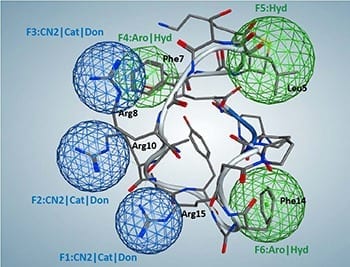
The most promising of them may literally be the key to controlling hypertension
A team of University of California, San Diego researchers has designed new compounds that mimic those naturally used by the body to regulate blood pressure. The most promising of them may literally be the key to controlling hypertension, switching off the signaling pathways that lead to the deadly condition.
Published online this month in Bioorganic & Medicinal Chemistry, the scientists studied the properties of the peptide called catestatin that binds nicotinic acetylcholine receptors found in the nervous system, and developed a pharmacophore model of its active centers. They next screened a library of compounds for molecules that might match this 3D “fingerprint”. The scientists then took their in-silico findings and applied them to lab experiments, uncovering compounds that successfully lowered hypertension.
“This approach demonstrates the effectiveness of rational design of novel drug candidates,” said lead author Igor F. Tsigelny, a research scientist with the university’s San Diego Supercomputer Center (SDSC), as well as the UC San Diego Moores Cancer Center and the Department of Neurosciences.
“Our results suggest that analogs can be designed to match the action of catestatin, which the body uses to regulate blood pressure,” said Daniel T. O’Connor, a professor at the UC San Diego School of Medicine and senior author of the study. “Those designer analogs could ultimately be used for treatment of hypertension or autonomic dysfunction.”
The research may lead to a new class of treatments for hypertension, a disease which affects about 76 million people, or about one in three adults, in the United States, according to the American Heart Association. Untreated, it damages the blood vessels and is a leading risk factor for kidney failure, heart attack, and stroke.
Despite being a common and lethal cardiovascular risk factor, hypertension remains only partially controlled by current antihypertensive medications, most of which have serious side effects. Specifically, the SDSC/UC San Diego researchers targeted the hormone catestatin for therapeutic potential. Catestatin acts as the gatekeeper for the secretion of catecholamines – hormones that are released into the blood during times of physical or emotional stress. A drug that mimics the action of catestatin would thus allow people to control the hormones that regulate blood pressure.
The Latest Bing News on:
Hypertension
- Taking Medication for High Blood Pressure May Lower Risk of Uterine Fibroids, Study Findson May 1, 2024 at 12:12 pm
A new study suggests a link between taking medication for hypertension, or high blood pressure, and a reduced risk of developing uterine fibroids. Here's what to know.
- 4 Dangerous Exercises You Should Avoid If You Have High Blood Pressure, Trainers Warnon May 1, 2024 at 8:29 am
It’s always important to stay active and get exercise. However, certain health conditions, such as hypertension, can make especially strenuous forms of exercise dangerous. This is the case when it ...
- Air Pollution Ups Gestational Hypertension, Mostly in Prenatal Depression Caseson May 1, 2024 at 6:40 am
Researchers explored the effect of air pollution on gestational hypertension and preeclampsia, identifying time windows in which pollution exposure was most harmful.
- New research reveals genetic basis for blood pressure and hypertension tiskon May 1, 2024 at 6:18 am
A recent study delves into the genetic underpinnings of blood pressure regulation and the risk of developing hypertension. Researchers identified over 2,000 regions on the human genome, including more ...
- 2,000+ Genetic Signals Linked to Blood Pressure Discovered in Study of Over a Million Peopleon May 1, 2024 at 12:02 am
A new Queen Mary-led study reveals the most detailed picture yet of genetic contributors to blood pressure. The findings lead to improved polygenic risk scores, which will better predict blood ...
- Orchestra BioMed Expands Global Patent Portfolio for Hypertension Therapyon April 30, 2024 at 10:00 pm
NEW HOPE, PA — Orchestra BioMed Holdings, Inc. (Nasdaq: OBIO) has announced a significant expansion of its global patent portfolio, signaling a major stride in the development of atrioventricular ...
- Mediterranean Diet Linked to Lower Hypertension Risk, Study Findson April 30, 2024 at 5:30 am
The Mediterranean diet has well-established health benefits —lowering your risk of type 2 diabetes, heart attack, stroke, and dementia to name a few. Now, researchers in Greece found another: lowering ...
- Saudi Arabia Pulmonary Arterial Hypertension Market Size, Share, Growth Statistics, Leading Players and Forecast to 2024 to 2032on April 29, 2024 at 4:11 pm
Anticipated growth for ‘Saudi Arabia Pulmonary Arterial Hypertension Market’ is significant from 2024 to 2032. The market showed steady growth in 2024 and is expected to continue rising due to ...
- Can Mediterranean diet lower hypertension risk?on April 28, 2024 at 7:30 pm
In a study published in the journal European Journal of Clinical Nutrition, researchers found that people who consistently followed a Mediterranean-style diet had a lower risk of developing ...
- SGLT2 Inhibitors vs. DPP4 Inhibitors: Study reveals new benefits of SGLT2i for prevention of hypertensionon April 23, 2024 at 9:30 pm
Japan: A recent study published in Hypertension Research using nationwide real-world data demonstrated the potential advantage of SGLT2 inhibitors over DPP4 inhibitors in reducing hypertension ...
The Latest Google Headlines on:
Hypertension
[google_news title=”” keyword=”Hypertension” num_posts=”10″ blurb_length=”0″ show_thumb=”left”]
The Latest Bing News on:
Controlling hypertension
- High Blood Pressure: Lower Your Number With These Vegetableson May 2, 2024 at 5:16 am
Leafy vegetables are highly nutritious. Research has shown that leafy greens can help lower blood pressure as well as boost overall cardiovascular health. Spinach, kale and mustard greens are some ...
- Taking Medication for High Blood Pressure May Lower Risk of Uterine Fibroids, Study Findson May 1, 2024 at 12:12 pm
A new study suggests a link between taking medication for hypertension, or high blood pressure, and a reduced risk of developing uterine fibroids. Here's what to know.
- Five reasons your blood pressure medication isn't workingon May 1, 2024 at 9:23 am
Keeping your blood pressure in check is a good way to lower your risk of heart disease, stroke, and kidney disease. So, you follow orders, take your prescribed medication, and proudly accept your ...
- New procedure at Erie hospital offers hope for those with stubbornly high blood pressureon April 30, 2024 at 7:04 am
Five different medications couldn't control Steven Davis' high blood pressure. Despite taking the pills every day, the 73-year-old Millcreek Township man's blood pressure often remained between 160/90 ...
- Stroke Level Blood Pressure: Determining Risk Based on Levelson April 29, 2024 at 8:40 am
Managing blood pressure levels is a modifiable risk factor for stroke. This article examines how high levels go before a hypertensive crisis with stroke.
- Could blood pressure be better controlled with new FDA-approved treatment? What to know.on April 26, 2024 at 7:07 pm
Renal denervation at Heart Hospital of Austin helps Texas woman get her blood pressure in better control after 30 years of medications not working.
- Counties with the highest rates of high blood pressure in Californiaon April 25, 2024 at 8:21 am
Stacker compiled a list of counties with the highest rates of high blood pressure in California using data from the Centers for Disease Control and Prevention.
- Counties with the highest rates of high blood pressure in New Mexicoon April 25, 2024 at 8:21 am
Stacker compiled a list of counties with the highest rates of high blood pressure in New Mexico using data from the Centers for Disease Control and Prevention.
- Counties with the highest rates of high blood pressure in Texason April 25, 2024 at 7:33 am
Stacker compiled a list of counties with the highest rates of high blood pressure in Texas using data from the Centers for Disease Control and Prevention.
- Counties with the highest rates of high blood pressure in Idahoon April 25, 2024 at 7:33 am
Stacker compiled a list of counties with the highest rates of high blood pressure in Idaho using data from the Centers for Disease Control and Prevention.
The Latest Google Headlines on:
Controlling hypertension
[google_news title=”” keyword=”controlling hypertension” num_posts=”10″ blurb_length=”0″ show_thumb=”left”]










